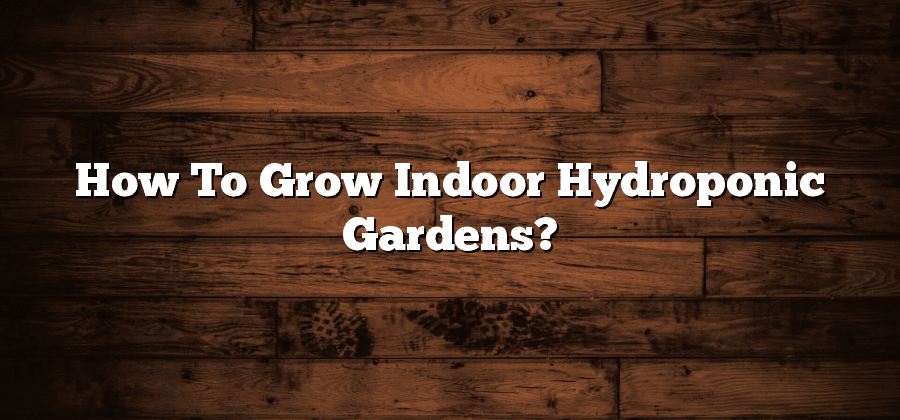The Basics of Indoor Hydroponic Gardening
Indoor hydroponic gardening is a method of cultivating plants without soil, utilizing nutrient-rich water instead. This innovative technique has gained popularity due to its numerous advantages over traditional soil-based gardening. In indoor hydroponics, plants are grown in a controlled environment, allowing for optimal growth and year-round cultivation. This method also offers higher yields, faster growth rates, and requires less water compared to traditional gardening methods.
One of the key principles of indoor hydroponic gardening is the delivery of nutrients directly to the plant roots. This is done by suspending the plant in a water-based solution that contains all the essential minerals required for growth. The absence of soil allows for better control over nutrient levels, pH balance, and overall plant health. By adjusting these factors, gardeners can create the ideal conditions for plants to thrive and maximize their harvests.
Choosing the Right Indoor Hydroponic System
When it comes to choosing the right indoor hydroponic system for your garden, there are several factors to consider. First and foremost, determine the size of your indoor space and the number of plants you plan on growing. This will help you determine the appropriate size and capacity of the system you need. Additionally, think about your level of experience with hydroponics. If you’re a beginner, a simple system with easy-to-follow instructions may be the best choice. On the other hand, if you’re a seasoned hydroponic gardener looking for more advanced features and customization options, there are systems available to meet those needs as well.
Another important factor to consider is the type of plants you plan on growing. Different plants have different nutrient and environmental requirements, so it’s crucial to select a system that can cater to those specific needs. For example, some systems are designed specifically for leafy greens like lettuce and spinach, while others are better suited for flowering plants like tomatoes and peppers. Researching the specific requirements of your chosen plants will help guide your decision-making process.
Selecting the Perfect Location for Your Indoor Garden
When it comes to selecting the perfect location for your indoor garden, there are a few key factors to consider. The first thing to think about is the amount of sunlight that the space receives. Ideally, you want a location that gets at least six to eight hours of direct sunlight per day. This will ensure that your plants have the energy they need to grow and thrive.
Additionally, it’s important to choose a location that has good air circulation. Plants in an indoor garden need fresh air to exchange carbon dioxide for oxygen. Look for a space that has windows or vents that can be opened to allow for proper airflow.
Lastly, consider the temperature and humidity levels in the chosen location. Most indoor plants prefer temperatures between 65-75 degrees Fahrenheit and humidity levels around 40-60%. Be mindful of any heating or cooling sources nearby that may affect the temperature in the space.
By carefully considering these key factors, you can choose the perfect location for your indoor garden, setting it up for success and ensuring optimal growth for your plants.
Essential Equipment and Supplies for Indoor Hydroponics
Indoor hydroponics offers an efficient and controlled way to grow plants without the need for soil. To ensure the success of your indoor garden, it’s important to have the essential equipment and supplies in place. The first item on your list should be a quality grow light, as plants in hydroponic systems rely heavily on artificial lighting for photosynthesis. LED lights are commonly used in indoor gardens due to their energy efficiency and ability to provide the specific light spectrum required for optimal plant growth. Additionally, a timer is essential to automate the lighting schedule and create consistency for your plants.
Another crucial piece of equipment is a reservoir, which is used to hold the nutrient solution. This nutrient-rich water serves as the primary source of nourishment for your plants. Look for a reservoir that is made of durable material and has a sufficient capacity to accommodate the size of your hydroponic system. It’s also important to have a reliable pH meter and pH adjusters to monitor and regulate the acidity levels of the nutrient solution. Proper pH levels ensure that your plants are able to absorb the nutrients effectively. Moreover, an air pump and air stones are needed to provide oxygen to the roots of your plants, promoting healthy growth and preventing root rot.
Understanding Nutrient Solutions for Optimal Growth
Nutrient solutions play a crucial role in the success of your indoor hydroponic garden. These solutions are specially formulated to provide the necessary minerals and nutrients that plants need to grow and thrive. By understanding the different components of nutrient solutions, you can ensure optimal growth and maximize the potential of your indoor garden.
One of the key elements to consider when it comes to nutrient solutions is the balance of macronutrients and micronutrients. Macronutrients, such as nitrogen, phosphorus, and potassium, are needed by plants in larger quantities, while micronutrients, such as iron, zinc, and copper, are required in smaller amounts. Achieving the right balance between these nutrients is essential to prevent deficiencies or toxicities in your plants. Additionally, the pH level of your nutrient solution plays a crucial role in nutrient absorption. It is important to monitor and adjust the pH level regularly to ensure that your plants can efficiently absorb the nutrients they need.






